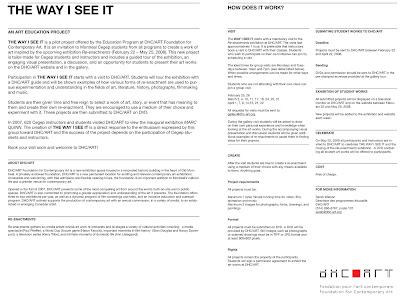assignments
1 keyword/database portrait: an exercise in ‘database’ storytelling, visual literacy/composition, creative use of image/text elements; an introduction to the mac environment, file preparation, scanning, basic photoshop and on-line user-generated content frameworks. students are asked to produce a ‘portrait’ of a loved one via an ‘illustrated’ database 10 keywords linked to image and text representations. the words should be drawn from a loosely thematic list of terms that represent or give expression to an aspect of the subject’s personality/interests/ experience. consider the sound quality of the words and their potential for rhythm, rhyme when placed in sequence. illustrational components can be drawn from a range of sources (family albums, books, atlases, art books, magazines, letters, comics, editorial pieces), and can depict people, things, places or abstractions—colour, texture, light, etc.. they should provide both descriptive and symbolic support for the keyword and be visually and conceptually cohesive. keywords and illustrations will be linked via an on-line framework. presented in class february 14. 15%
2 self-portrait panorama: an exercise in visual storytelling and introduction to image file-formats, sizing and photoshop basics. using found or created visual imagery students are asked to produce a panoramic self-portrait that describes a defining event or a significant relationship in the student’s life. the final portrait will be comprised of a series of six (6) images. as above, these materials can include a range of imagery but may only include one picture of the students themselves. images should communicate something about the student’s interests and values and be considerate of the formal aspects of both the individual pictures and all elements as they cohere in the group—the tone, texture, contrast, and scale of each individual element should work together harmoniously. when choosing images, pay attention to the consistency of time and space that is represented. additionally, the order should be carefully considered. for the final presentation, each image will be cropped, and have contrast adjusted to suit the graphic sensibility of the whole. images will be saved in jpeg formatted and posted to the student’s website or blog, to be presented in class march 6 ~15%
alternative assignment ~ a tableau: students will integrate (a minimum) of three source images into a single image frame to create a collage or ‘surrealist’ representation of a fictional scene or event—domestic, public, catastrophic, dramatic, comic... The scene can represent an original theme or can synthesize themes from a film you have made, seen and/or admire. Source imagery can be taken from a number of sources—newspapers, magazines, snapshots. The final work can be reproduced as a poster, cd/dvd cover image or a stand-alone print. images will be saved in jpeg formatted and posted to the student’s website or blog, to be presented in class march 6 ~15%
3 ‘opening credits’: an exercise studying the relationship of image and text, sound and movement + an introduction to finalcut and garage band. students will conceive, storyboard and produce a one-minute, credit sequence for a hypothetical film (fiction or doc). the credit sequence will integrate image, text, sound and movement and offer a succinct summary of the film’s themes, tone and story. source imagery can be still or moving, sound can be recorded, copied or mastered: to be presented in class april 3. 20%
4 ‘final project’/digital story': this final project brings together skills garnered over the course of the term in a final, fully developed media art work of the student’s choice. students are responsible for drafting and presenting a proposal for the project in advance of production. proposals are due april 24 (10%) final projects are due may 9. 25%

No comments:
Post a Comment